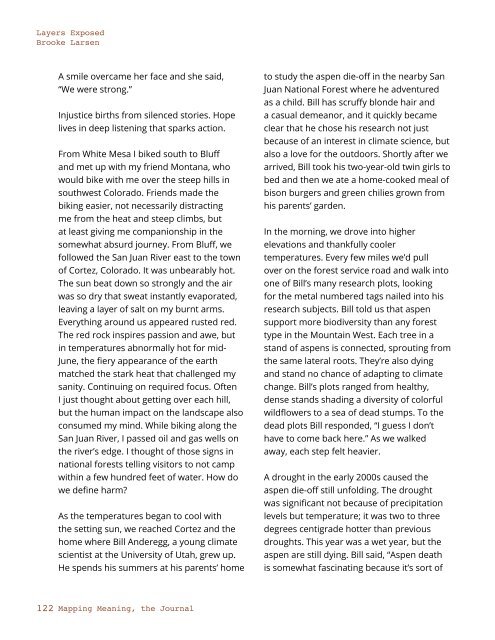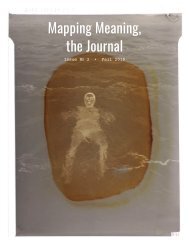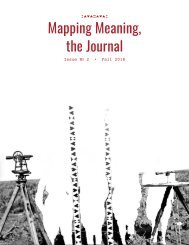Mapping Meaning, the Journal (Issue No. 1)
You also want an ePaper? Increase the reach of your titles
YUMPU automatically turns print PDFs into web optimized ePapers that Google loves.
Layers Exposed<br />
Brooke Larsen<br />
A smile overcame her face and she said,<br />
“We were strong.”<br />
Injustice births from silenced stories. Hope<br />
lives in deep listening that sparks action.<br />
From White Mesa I biked south to Bluff<br />
and met up with my friend Montana, who<br />
would bike with me over <strong>the</strong> steep hills in<br />
southwest Colorado. Friends made <strong>the</strong><br />
biking easier, not necessarily distracting<br />
me from <strong>the</strong> heat and steep climbs, but<br />
at least giving me companionship in <strong>the</strong><br />
somewhat absurd journey. From Bluff, we<br />
followed <strong>the</strong> San Juan River east to <strong>the</strong> town<br />
of Cortez, Colorado. It was unbearably hot.<br />
The sun beat down so strongly and <strong>the</strong> air<br />
was so dry that sweat instantly evaporated,<br />
leaving a layer of salt on my burnt arms.<br />
Everything around us appeared rusted red.<br />
The red rock inspires passion and awe, but<br />
in temperatures abnormally hot for mid-<br />
June, <strong>the</strong> fiery appearance of <strong>the</strong> earth<br />
matched <strong>the</strong> stark heat that challenged my<br />
sanity. Continuing on required focus. Often<br />
I just thought about getting over each hill,<br />
but <strong>the</strong> human impact on <strong>the</strong> landscape also<br />
consumed my mind. While biking along <strong>the</strong><br />
San Juan River, I passed oil and gas wells on<br />
<strong>the</strong> river’s edge. I thought of those signs in<br />
national forests telling visitors to not camp<br />
within a few hundred feet of water. How do<br />
we define harm?<br />
As <strong>the</strong> temperatures began to cool with<br />
<strong>the</strong> setting sun, we reached Cortez and <strong>the</strong><br />
home where Bill Anderegg, a young climate<br />
scientist at <strong>the</strong> University of Utah, grew up.<br />
He spends his summers at his parents’ home<br />
to study <strong>the</strong> aspen die-off in <strong>the</strong> nearby San<br />
Juan National Forest where he adventured<br />
as a child. Bill has scruffy blonde hair and<br />
a casual demeanor, and it quickly became<br />
clear that he chose his research not just<br />
because of an interest in climate science, but<br />
also a love for <strong>the</strong> outdoors. Shortly after we<br />
arrived, Bill took his two-year-old twin girls to<br />
bed and <strong>the</strong>n we ate a home-cooked meal of<br />
bison burgers and green chilies grown from<br />
his parents’ garden.<br />
In <strong>the</strong> morning, we drove into higher<br />
elevations and thankfully cooler<br />
temperatures. Every few miles we’d pull<br />
over on <strong>the</strong> forest service road and walk into<br />
one of Bill’s many research plots, looking<br />
for <strong>the</strong> metal numbered tags nailed into his<br />
research subjects. Bill told us that aspen<br />
support more biodiversity than any forest<br />
type in <strong>the</strong> Mountain West. Each tree in a<br />
stand of aspens is connected, sprouting from<br />
<strong>the</strong> same lateral roots. They’re also dying<br />
and stand no chance of adapting to climate<br />
change. Bill’s plots ranged from healthy,<br />
dense stands shading a diversity of colorful<br />
wildflowers to a sea of dead stumps. To <strong>the</strong><br />
dead plots Bill responded, “I guess I don’t<br />
have to come back here.” As we walked<br />
away, each step felt heavier.<br />
A drought in <strong>the</strong> early 2000s caused <strong>the</strong><br />
aspen die-off still unfolding. The drought<br />
was significant not because of precipitation<br />
levels but temperature; it was two to three<br />
degrees centigrade hotter than previous<br />
droughts. This year was a wet year, but <strong>the</strong><br />
aspen are still dying. Bill said, “Aspen death<br />
is somewhat fascinating because it’s sort of<br />
122 <strong>Mapping</strong> <strong>Meaning</strong>, <strong>the</strong> <strong>Journal</strong>







